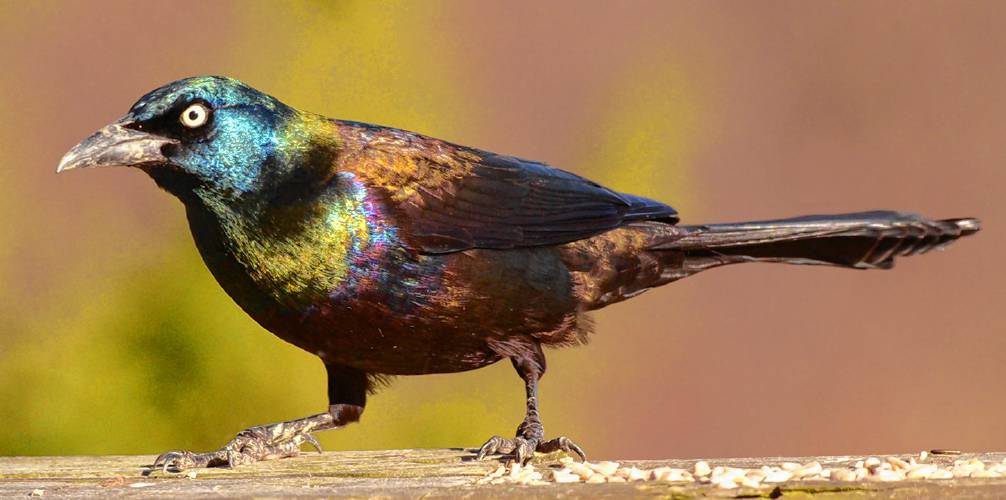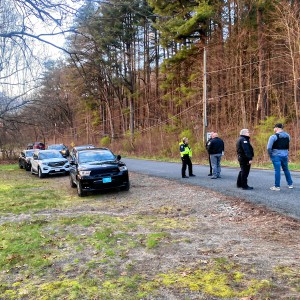Speaking of Nature: Is this Grackle really common? Behold the bird’s colorful iridescence on a sunny day

This male common grackle, seen in the direct sunlight of a clear day, positively glows with iridescence of every color. PHOTO BY BILL DANIELSON
| Published: 03-25-2024 6:01 AM |
After a while, one learns what to expect with each month and each season. July is going to be hot and humid, October will be colorful and somewhat melancholy, January will be cold and sleepy, and then there is March. March is the month for which the term “madness” is oh so appropriate.
Is it spring, or is it winter? What, exactly, is going on out there anyway?
So far we have had quite a bizarre start to the season. We acknowledged the official equinox on March 19, which was a strange date until you remember that this is a leap year. Strange as that might be, we are also in the grip of a strong El Nino this year and things are definitely different. My summer vacation is going to be a full two weeks longer this year because we only had one snow day this winter. I’ve only had to use my brand new snow blower twice and there was a moment in February that struck me as particularly strange.
At 2 p.m. on February 9, I was sitting out on my deck (the first indication that something strange was afoot) and I was utterly astounded when I was visited by a honeybee. This, I thought, was not good at all. The warm weather was causing truly strange things to happen and the appearance of a bee, in what anyone would recognize as solidly situated in the middle of winter, was alarming. What the what?
And yet, despite all of these strange things unfolding around me, there was one bird that seemed determined to be uncooperative. The Common Grackle (Quiscalus quiscula) is dependably one of the first migratory species to appear in our area every year. In the past I have seen them as early as February 11 and this I thought would be a year when they would arrive early once again.
This was of particular interest to me because a new record for species observed in my yard during the month of February was on the table. Regular readers of my column will remember the Brown Creeper that I wrote about in February and that particular bird represented the tying species. I just needed one more bird to break the record and the grackle was just the species to do it … but it never showed.
Even with the extra day in February, I didn’t see my first grackle until March 2. Rats! I marked the appearance of grackles in my red journal with a sarcastic comment and took a few photos to document the occasion. It was a rainy day and the diffuse light produced an interesting effect on the birds’ feathers. It turns out that when you look at a grackle in the right light you see that they are not black at all. Instead, their feathers are a rainbow of color. All of these colors are visible on a cloudy day, but you get the mellow versions of each; soft pastels that hint at what might be.
One of these photos was particularly beautiful and I almost used it in a column, but then the whole merganser thing happened and I put the grackle on the “next week” pile. This might have been a lucky thing because a week later I caught a glimpse of some grackles in the direct sunlight of a beautiful blue-sky day. The bird was standing on my porch railing and feasting on a very strategically-positioned pile of sunflower seeds. Simply put, he was dazzlingly spectacular.
Article continues after...
Yesterday's Most Read Articles
 Police report details grisly crime scene in Greenfield
Police report details grisly crime scene in Greenfield
 Authorities ID victim in Greenfield slaying
Authorities ID victim in Greenfield slaying
 State records show Northfield EMS chief’s paramedic license suspended over failure to transport infant
State records show Northfield EMS chief’s paramedic license suspended over failure to transport infant
 New buyer of Bernardston’s Windmill Motel looks to resell it, attorney says
New buyer of Bernardston’s Windmill Motel looks to resell it, attorney says
 On The Ridge with Joe Judd: What time should you turkey hunt?
On The Ridge with Joe Judd: What time should you turkey hunt?
 Ethics Commission raps former Leyden police chief, captain for conflict of interest violations
Ethics Commission raps former Leyden police chief, captain for conflict of interest violations
What had been a collection of mellow pastels was now a glowing splendor of iridescence. There were too many photos to try to choose from and it pained me to have to pick only one. The males were not only glowing with what looked like an internal fire, but they were also displaying at one another and showing off their characteristic blackbird posturing. A bird will point his beak to the sky, swell up with what looks like an involuntary inflation of helium, and then burst out into a squeaky “song” as if he is trying to suppress a sneeze. The problem is that the inflation of his feathers would mean that none of them would adequately show all of the colors that I wanted to share with you.
So, in the end I chose a photo that shows a male grackle in the mundane process of eating, but with almost all of his feathers compressed flat against his body. Still, the feathers were at slightly different angles that would allow their internal prisms to refract the light into all of the colors of the rainbow.
His head is blue and green, his neck and upper breast shine with metallic gold, his back and wings glow with metallic copper and right under his armpit there is a patch of the most sublime blue, purple and red. The word “common” just doesn’t do this grackle justice.
And now March has played its trick on us once again. We heard spring peepers on March 14, but as I sit and write this column the temperature is 21 degrees Fahrenheit and it has been snowing. Now that spring is officially here, winter has decided to rouse from her El Nino-induced stupor and get to work.
Give it up! Free us from this madness. Let us once again wander outside and feel the sunshine upon our faces. There will be plenty of time for snow and cold next year.
Bill Danielson has been a professional writer and nature photographer for 26 years. He has worked for the National Park Service, the US Forest Service, the Nature Conservancy and the Massachusetts State Parks and he currently teaches high school biology and physics. For more in formation visit his website at www.speakingofnature.com, or go to Speaking of Nature on Facebook.

 Proof that it’s never too late: Solo exhibit and free workshops honor the late Frederick Gao, a Belchertown resident who became a painter in his last five years
Proof that it’s never too late: Solo exhibit and free workshops honor the late Frederick Gao, a Belchertown resident who became a painter in his last five years Self-expression on display: ServiceNet members’ artworks on view at Greenfield Public Library through end of May
Self-expression on display: ServiceNet members’ artworks on view at Greenfield Public Library through end of May Embracing both new and old: Da Camera Singers celebrates 50 years in the best way they know how
Embracing both new and old: Da Camera Singers celebrates 50 years in the best way they know how Time to celebrate kids and books: Mass Kids Lit Fest offers a wealth of programs in Valley during Children’s Book Week
Time to celebrate kids and books: Mass Kids Lit Fest offers a wealth of programs in Valley during Children’s Book Week
